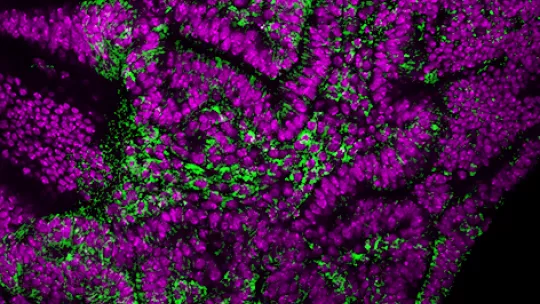Images
Researchers at IRB Barcelona's Development and Growth Control lab have revealed the mechanisms by which cells enter senescence because of an imbalance in the number of chromosomes.
Chromosomal instability is a common trait in most solid tumours, such as carcinoma, and fully understanding its relationship with cancer can help identify new therapeutic targets.
The results have been published in the journal Developmental Cell.
Chromosomal instability is a feature of solid tumours such as carcinoma. Likewise, cellular senescence is a process that is highly related to cellular ageing and its link to cancer is becoming increasingly clear. Scientists led by ICREA researcher Dr. Marco Milán at IRB Barcelona have revealed the link between chromosomal instability and cellular senescence.
“Chromosomal instability and senescence are two characteristics common to most tumours, and yet it was not known how one related to the other. Our studies indicate that senescence may be one of the intermediate links between chromosomal alterations and cancer," says Dr. Milan, head of the Development and Growth Control laboratory at IRB Barcelona.
"The behaviour we saw in cells with chromosomal instability made us think that they could be senescent cells and indeed that was the case!" says Dr. Jery Joy, first author of the article published in Developmental Cell.
The study has been conducted on the fly Drosophila, an animal model commonly used in biomedicine, and the mechanisms described may help to understand the contribution of chromosomal instability and senescence to cancer, and facilitate the identification of possible therapeutic targets.
Reversing the effects of chromosomal instability
The researchers from the Development and Growth Control lab have shown that, in an epithelial tissue with high levels of chromosomal instability, those cells with an altered balance of chromosome number detach from their neighbouring cells and enter senescence. Senescent cells are characterised by a permanently halted cell cycle and by the secretion of a large number of proteins. This abnormal secretion of proteins alters the surrounding tissue, alerting the immune system and causing inflammation.
If the senescent cells are not eliminated by the body immediately, they promote abnormal growth of the surrounding tissue, leading to malignant tumours. "If we identify the mechanisms by which we can lower the number of senescent cells, then we will be able to reduce the growth of these tumours," says Dr. Milan. "In fact, this study shows that this is possible, at least in Drosophila," says Dr. Joy.
Cells with an unbalanced number of chromosomes accumulate a high number of aberrant mitochondria and, therefore, a high level of oxidative stress, which in turn activates the JNK signalling pathway, triggering entry into senescence. "We have shown that reducing this high anomalous number of mitochondria, or regulating the oxidative stress that they induce, is sufficient to decrease the number of senescent cells and the negative effects of chromosomal instability," reiterates Dr. Joy.
These findings open new avenues of research to find therapeutic targets and reduce senescence levels caused by chromosomal instability in solid tumours.
Extrapolating from the fly to mammals
The vinegar fly, Drosophila melanogaster, is a widely used in biomedicine. It is a valuable animal model in cancer research because of its short life cycle, the availability of a large number of genetic tools, and the presence of the same genes as in humans, but with a lower level of redundancy.
In fact, experiments designed to dissect the causal relationship between cellular behaviour or characteristics in human tumours, such as chromosomal instability and senescence, are more easily analysed in this model organism.
Future laboratory work will continue to dissect the molecular mechanisms responsible for cellular behaviours found in solid tumours of epithelial origin produced by the mere induction of chromosomal instability. "The more we understand the biology of a tissue subjected to chromosomal instability and the molecular mechanisms responsible for the cellular behaviours that emerge and give rise to malignant tumours, the greater our chances of designing effective therapies and reducing the growth and malignancy of human carcinomas," concludes Dr. Milan.
This work was financed by the Ministry of Science and Innovation and the ERDF.
Related article:
Proteostasis failure and mitochondrial dysfunction leads to aneuploidy-induced senescence
Jery Joy, Lara Barrio, Celia Santos-Tapia, Daniela Romão, Nikolaos Nikiforos Giakoumakis, Marta Clemente-Ruiz & Marco Milán
Developmental Cell (2021) DOI: 10.1016/j.devcel.2021.06.009
About IRB Barcelona
The Institute for Research in Biomedicine (IRB Barcelona) pursues a society free of disease. To this end, it conducts multidisciplinary research of excellence to cure cancer and other diseases linked to ageing. It establishes technology transfer agreements with the pharmaceutical industry and major hospitals to bring research results closer to society, and organises a range of science outreach activities to engage the public in an open dialogue. IRB Barcelona is an international centre that hosts 400 researchers and more than 30 nationalities. Recognised as a Severo Ochoa Centre of Excellence since 2011, IRB Barcelona is a CERCA centre and member of the Barcelona Institute of Science and Technology (BIST).












